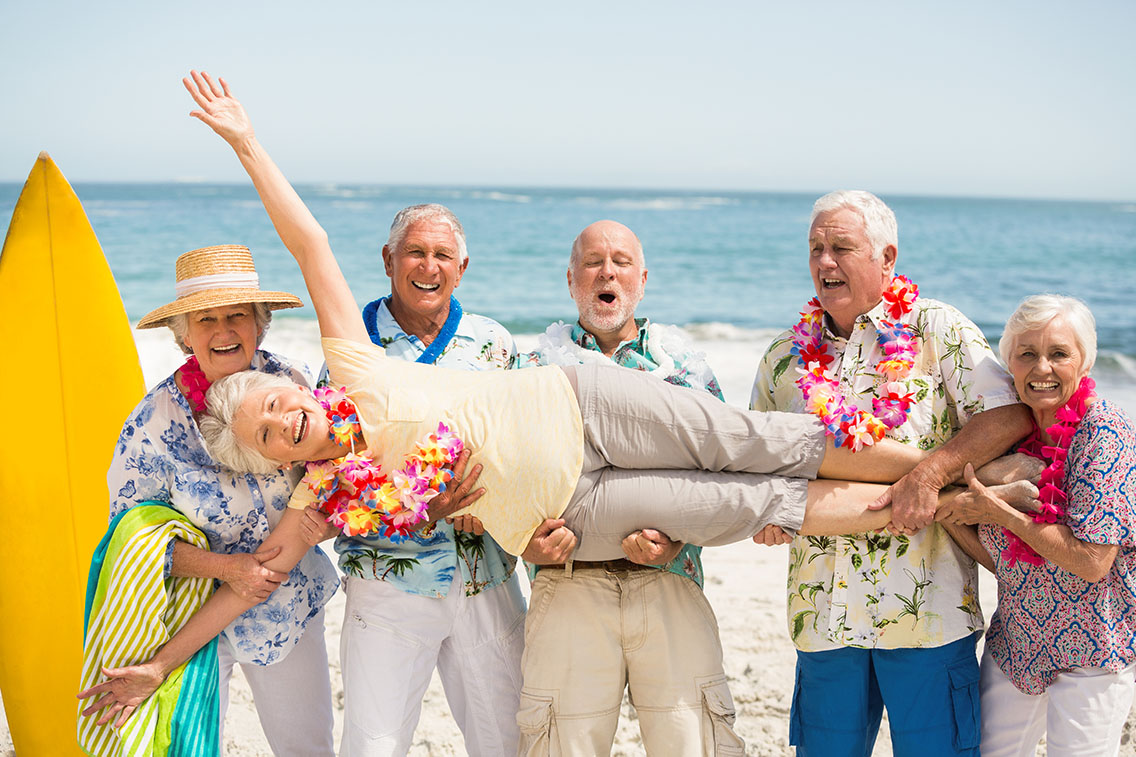Vacations for single senior citizens offer a unique blend of relaxation, adventure, and cultural exploration. This guide delves into the planning and execution of fulfilling and safe solo trips, catering to diverse interests and activity levels. Whether you envision a tranquil beach escape, an exhilarating multi-city tour, or a luxurious cruise, we explore options designed to maximize enjoyment and minimize stress for independent senior travelers.
We’ll cover everything from choosing the right destination and budget to addressing safety concerns and maximizing social opportunities. The goal is to empower single senior citizens to confidently plan and enjoy unforgettable solo vacations that enrich their lives and create lasting memories.
Types of Vacations
Choosing the right vacation is crucial for single senior citizens, ensuring a fulfilling and enjoyable experience tailored to their preferences and physical capabilities. A well-planned trip can offer relaxation, adventure, cultural enrichment, or a combination of these elements, fostering independence and creating lasting memories. Consideration should be given to accessibility, pace, and personal interests when selecting a vacation type.
Vacation Options for Single Senior Citizens
The following table categorizes suitable vacation types based on activity levels, providing descriptions and example locations. Remember to always check accessibility features before booking.
| Vacation Type | Activity Level | Description | Example Location |
|---|---|---|---|
| Relaxing Beach Vacation | Low | Enjoy leisurely days on the beach, swimming in calm waters, and indulging in spa treatments. Focus is on rest and rejuvenation. | Maui, Hawaii |
| Cultural City Break | Moderate | Explore historical sites, museums, and art galleries at a comfortable pace. Enjoy local cuisine and immerse yourself in the culture. | Florence, Italy |
| Adventure Tour (Guided) | Moderate-High | Participate in guided tours that offer moderate physical activity, such as hiking or biking, with built-in rest periods and accessibility considerations. | Costa Rica (guided rainforest tours) |
| River Cruise | Low | Enjoy scenic river views, onboard amenities, and leisurely shore excursions. Minimal physical exertion required. | Rhine River, Germany |
| Wellness Retreat | Low-Moderate | Focus on health and well-being through yoga, meditation, healthy eating, and spa treatments. Offers a relaxing and rejuvenating experience. | Sedona, Arizona |
Cruise Vacations for Seniors
Cruises are increasingly popular among senior travelers due to their all-inclusive nature and variety of amenities. Many cruise lines offer senior-specific programs and benefits, such as discounts, shore excursions tailored for seniors, and accessible cabins. Onboard amenities often include wellness centers, lectures, and entertainment geared towards older adults, ensuring a comfortable and engaging experience. For example, some lines offer specialized cruises focused on specific interests, like history or art, catering to mature travelers’ preferences.
All-Inclusive Resorts for Solo Travelers
All-inclusive resorts offer a convenient and cost-effective option for single senior travelers. The “all-inclusive” aspect eliminates the need for constant budgeting and planning for meals and activities, reducing stress and allowing for greater relaxation. Many resorts offer a range of activities and amenities suitable for all fitness levels, including swimming pools, spa facilities, and organized excursions. The social aspect of these resorts can also combat loneliness, providing opportunities to meet other travelers. The upfront cost provides a clear budget, minimizing unexpected expenses.
Sample Multi-City Tour Itinerary (7 Days)
This itinerary focuses on manageable pacing and accessibility, suitable for a single senior traveler interested in history and culture.
Day 1: Arrive in London, check into an accessible hotel near major attractions. Afternoon: Guided walking tour of Westminster Abbey and Houses of Parliament (consider a wheelchair-accessible tour). Evening: Dinner at a traditional pub.
Day 2: Morning: Visit the Tower of London. Afternoon: Relaxing afternoon tea at a hotel. Evening: Attend a West End show (choose a show with convenient seating).
Day 3: High-speed train to Paris. Check into accessible hotel near the Eiffel Tower. Afternoon: Eiffel Tower visit (pre-booked accessible tickets recommended). Evening: Seine River cruise.
Day 4: Morning: Visit the Louvre Museum (pre-booked tickets and consider a guided tour focusing on key highlights to manage pacing). Afternoon: Explore the charming streets of Montmartre. Evening: Enjoy a traditional French dinner.
Day 5: Day trip to Versailles Palace (pre-booked accessible transportation and tickets). Allow ample time for rest and breaks.
Day 6: Morning: Visit the Musée d’Orsay. Afternoon: Relax and enjoy Parisian cafes. Evening: Farewell dinner.
Day 7: Depart from Paris.
This itinerary incorporates rest days, pre-booked transportation and tickets to minimize stress, and focuses on major attractions with accessibility options. Adjustments can be made based on individual preferences and physical capabilities.
Destination Considerations
Choosing the right destination is paramount for a successful and enjoyable vacation, especially for single senior citizens. Several factors need careful consideration to ensure a trip that is both relaxing and safe, balancing the desire for adventure with the need for comfort and accessibility. This section will explore key aspects of destination selection for solo senior travelers.
Domestic versus International Travel for Single Senior Citizens
Domestic travel often presents advantages in terms of cost and convenience. Shorter travel times mean less fatigue, and familiarity with the language and customs can reduce stress. However, international travel can offer a wider range of experiences and cultural immersion. The decision depends on individual preferences, budget, and health considerations. For example, a senior citizen with limited mobility might find a domestic trip to a national park with accessible trails more suitable than an extensive backpacking trip in Southeast Asia. Conversely, a healthy and adventurous senior might find the unique cultural experiences of a European city more appealing despite the longer travel time. Cost considerations are significant; domestic flights and accommodations are typically less expensive than international options.
Ideal Destinations for Solo Senior Travelers
Three destinations well-suited for solo senior travelers include:
- San Sebastian, Spain: This coastal city offers a beautiful setting with stunning beaches, delicious Basque cuisine, and a walkable old town. The generally mild climate is comfortable for most of the year, and the city is relatively easy to navigate on foot or using public transportation. Many restaurants and shops cater to tourists, and the overall atmosphere is welcoming and safe.
- Charleston, South Carolina, USA: This charming Southern city boasts a rich history, beautiful architecture, and a relaxed atmosphere. The city is relatively flat and easy to explore on foot, with a well-developed public transportation system. The climate is mild, with warm summers and pleasant winters. The abundance of historical sites, museums, and art galleries provides plenty of options for solo exploration. The hospitality of the local people is renowned.
- Quebec City, Canada: This historic city offers a unique blend of European charm and North American convenience. The old town is easily walkable, with cobblestone streets and charming architecture. The city’s compact size makes it easy to navigate, and the public transportation system is efficient. The climate is similar to many parts of Northern Europe, with distinct seasons and a beautiful autumn. The city’s French-Canadian culture provides a unique and enriching experience.
Transportation Options for Solo Senior Travelers
The choice of transportation significantly impacts the ease and enjoyment of a solo trip.
- Cruises: Offer all-inclusive packages with meals, entertainment, and transportation. However, they can be expensive and may not allow for in-depth exploration of destinations.
- Organized Tours: Provide structure and convenience, with pre-arranged itineraries and transportation. They can be less flexible than independent travel but offer peace of mind and social interaction.
- Independent Travel: Offers maximum flexibility but requires more planning and self-reliance. It can be more cost-effective but may be more challenging for seniors with mobility issues or limited travel experience.
Factors to Consider When Choosing a Destination
Several factors are crucial for single senior citizens planning a vacation:
- Safety: Choose destinations with low crime rates and a reputation for being safe for tourists. Research the area and consider staying in well-lit, secure accommodations.
- Accessibility: Ensure the destination is accessible to seniors with mobility limitations. Look for accommodations and transportation options that cater to the needs of travelers with disabilities.
- Healthcare Availability: Consider the availability of healthcare services in the chosen destination, including hospitals, clinics, and pharmacies. Check whether travel insurance covers medical emergencies.
- Climate: Choose a climate that is suitable for your health and preferences. Avoid destinations with extreme temperatures or harsh weather conditions.
- Budget: Plan your budget carefully, considering flights, accommodation, activities, and meals. Look for deals and discounts to save money.
Budgeting and Planning
Planning a vacation, especially as a single senior citizen, requires careful budgeting and meticulous planning to ensure a smooth and enjoyable trip. This section outlines a sample budget, details the planning process, and offers resources and strategies for affordable travel.
Sample Seven-Day Vacation Budget for a Single Senior Citizen
The following budget provides a reasonable estimate. Actual costs will vary depending on the destination, travel dates, and personal preferences. This example assumes a moderate level of spending.
| Category | Estimated Cost (USD) |
|---|---|
| Flights (round-trip) | $500 – $1000 |
| Accommodation (7 nights) | $700 – $1400 (mid-range hotel or Airbnb) |
| Activities & Entrance Fees | $350 – $700 (depending on chosen activities) |
| Meals (7 days) | $350 – $700 (mix of dining out and self-catering) |
| Transportation (local) | $100 – $200 (taxis, public transport, car rental) |
| Miscellaneous (souvenirs, tips, etc.) | $100 – $200 |
| Total Estimated Cost | $2100 – $4000 |
Planning a Solo Senior Citizen Vacation
Planning involves several key steps:
1. Destination Selection: Choose a destination based on interests, accessibility, and budget. Consider factors like climate, activities, and ease of navigation.
2. Booking Flights and Accommodation: Book flights and accommodation well in advance, especially during peak season, to secure better deals. Utilize flight comparison websites and review accommodation options carefully.
3. Arranging Transportation: Plan local transportation. Options include public transport, taxis, ride-sharing services, or renting a car depending on the destination and personal preference.
4. Scheduling Activities: Research and book activities in advance, especially popular tours or attractions. Consider purchasing a city pass for discounts on multiple attractions.
5. Packing and Preparing: Pack appropriately for the climate and planned activities. Make copies of important documents like passports, travel insurance, and itinerary. Inform someone of your travel plans.
6. Health and Safety: Consult your doctor about necessary vaccinations or precautions. Purchase comprehensive travel insurance.
7. Emergency Contacts: Keep a list of emergency contacts readily accessible.
Resources and Tools for Planning
Several resources can assist in planning a solo senior citizen vacation:
- Online Travel Agencies (OTAs): Expedia, Kayak, Booking.com offer flight and accommodation comparisons.
- Travel Blogs and Forums: Provide firsthand accounts and tips from fellow travelers.
- Senior-Specific Travel Agencies: Cater to the needs and preferences of senior travelers, often offering specialized tours and packages.
- Trip Planning Apps: Help organize itineraries, book activities, and track expenses.
Finding Affordable Travel Options and Senior Discounts
Several strategies can help secure affordable travel:
- Travel during the off-season or shoulder season: Avoid peak travel times for lower prices.
- Consider alternative accommodations: Explore options like hostels (if comfortable), guesthouses, or Airbnb for budget-friendly stays.
- Look for senior discounts: Many airlines, hotels, and attractions offer discounts for seniors (typically age 60+). Always inquire about discounts when booking.
- Take advantage of free activities: Explore free walking tours, visit parks and museums on free days, or enjoy local events.
- Pack light: Avoid checked baggage fees by packing efficiently.
Safety and Well-being
Embarking on a solo vacation as a senior citizen requires careful consideration of safety and well-being to ensure a fulfilling and worry-free experience. Prioritizing these aspects allows for a more enjoyable trip, maximizing relaxation and minimizing potential risks. This section addresses key safety measures and strategies for maintaining physical and mental health throughout your journey.
Travel Insurance and Emergency Contacts
Comprehensive travel insurance is paramount for single senior travelers. It provides crucial financial protection against unexpected medical emergencies, trip cancellations, lost luggage, and other unforeseen circumstances. Policies should ideally cover medical evacuation, repatriation, and emergency medical expenses, especially considering potential health vulnerabilities associated with aging. Before departure, ensure you have readily accessible contact information for your emergency contacts – family, friends, your doctor, and your insurance provider. Consider carrying a laminated card with this information, along with any relevant medical conditions or allergies. Providing a copy to a trusted individual at home is also recommended.
Personal Security Measures
Maintaining personal safety while traveling alone requires vigilance and proactive measures. Inform someone of your itinerary, including flight details, accommodation addresses, and planned activities. Regular check-ins via phone or email can provide reassurance. Avoid displaying large amounts of cash or expensive jewelry. Be aware of your surroundings and trust your instincts; if a situation feels unsafe, remove yourself from it. Utilize well-lit and populated areas, particularly at night. Familiarize yourself with local emergency numbers and transportation options before your trip.
Maintaining Physical and Mental Well-being
Traveling can be both exhilarating and tiring. Prioritizing physical and mental well-being is crucial for a positive experience. Pack comfortable shoes for walking and exploring. Incorporate light exercise into your daily routine, such as morning stretches or a short walk. Remember to stay hydrated, especially in warmer climates. Plan for downtime and relaxation; don’t overschedule your itinerary. Engage in activities you enjoy, whether it’s reading, listening to music, or simply enjoying the scenery. Mindfulness techniques, such as meditation or deep breathing exercises, can help manage stress and promote relaxation. Consider packing a small journal to record your thoughts and experiences.
Staying Connected with Loved Ones
Maintaining contact with family and friends while traveling alone combats feelings of loneliness and provides a sense of security. A mobile phone with international roaming or a local SIM card allows for easy communication. Regular calls or text messages can keep loved ones updated on your whereabouts and well-being. Consider using social media or messaging apps to share photos and updates. Scheduling video calls can foster a stronger sense of connection.
Packing Appropriately for a Vacation
Proper packing is essential for comfort and convenience. Pack lightweight, comfortable clothing suitable for the climate and planned activities. Include layers to adapt to changing temperatures. Don’t forget essential medications, ensuring you have sufficient supply for the duration of your trip, along with copies of prescriptions. Pack comfortable walking shoes and any necessary medical aids or assistive devices. A small first-aid kit containing bandages, antiseptic wipes, pain relievers, and any personal medications is advisable. Consider packing a reusable water bottle to stay hydrated.
Conclusion
Planning a fulfilling vacation as a single senior citizen requires careful consideration, but the rewards are immense. By thoughtfully assessing personal preferences, budgeting effectively, prioritizing safety, and embracing the opportunity for new experiences and social connections, solo travel can be an incredibly enriching and rewarding experience. Remember to embrace the freedom and flexibility that solo travel offers, and create a vacation that truly reflects your unique desires and needs.




